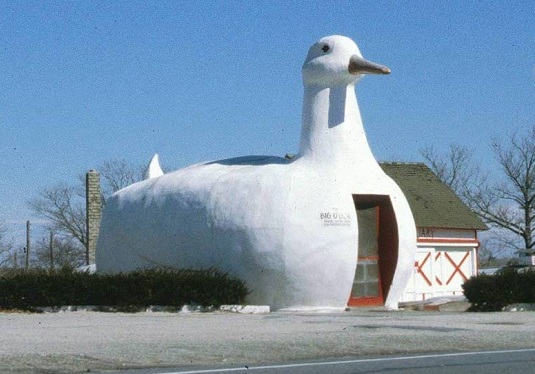Big Duck
The Big Duck is a building in the shape of a duck on Long Island, New York. It is an early example of mimetic architecture, where the design of the building mimics its purpose or function. The Big Duck was built in 1931 by Martin Maurer a duck farmer who used it as a shop to sell his produce.
The building is made from ferro-cement applied over a timber frame and wire mesh. It measures 5.5 m (18 ft) wide, 9.1 m (30 ft) long, and 6.1 m (20 ft) tall. The duck’s eyes are made from Ford Model-T tail lights.
Maurer moved the building to Flanders, Long Island, in 1937 where it stood until his duck ranch closed in 1984. Suffolk County acquired the building in 1988 and moved it elsewhere before it was returned to Flanders in 2007.
It was the inspiration for the Robert Venturi coined term ‘duck’, referring to a building that conforms to its purpose, and featured in his influential book ‘Learning from Las Vegas’.
Now containing a gift shop, the Big Duck is considered one of Long Island’s landmarks and was added to the National Register of Historic Places in 1997.
[edit] Related articles on Designing Buildings Wiki
- American architecture and construction.
- Fish Building, India.
- Gereja Ayam.
- Haines Shoe House.
- ING House.
- Lucy the elephant.
- Mimetic architecture.
- Owl House, South Korea.
- Piano Building.
- Robot Building, Bangkok.
- Sheep and Dog Buildings, Tirau.
- Teapot Dome Service Station.
- The Big Basket.
- The Headington Shark.
- The Kelpies.
- Unusual building design of the week.
- Wonder Egg, Japan.
Featured articles and news
The UK's Modern Industrial Strategy: A 10 year plan
Previous consultation criticism, current key elements and general support with some persisting reservations.
Building Safety Regulator reforms
New roles, new staff and a new fast track service pave the way for a single construction regulator.
Architectural Technologist CPDs and Communications
CIAT CPD… and how you can do it!
Cooling centres and cool spaces
Managing extreme heat in cities by directing the public to places for heat stress relief and water sources.
Winter gardens: A brief history and warm variations
Extending the season with glass in different forms and terms.
Restoring Great Yarmouth's Winter Gardens
Transforming one of the least sustainable constructions imaginable.
Construction Skills Mission Board launch sector drive
Newly formed government and industry collaboration set strategy for recruiting an additional 100,000 construction workers a year.
New Architects Code comes into effect in September 2025
ARB Architects Code of Conduct and Practice available with ongoing consultation regarding guidance.
Welsh Skills Body (Medr) launches ambitious plan
The new skills body brings together funding and regulation of tertiary education and research for the devolved nation.
Paul Gandy FCIOB announced as next CIOB President
Former Tilbury Douglas CEO takes helm.
UK Infrastructure: A 10 Year Strategy. In brief with reactions
With the National Infrastructure and Service Transformation Authority (NISTA).
Ebenezer Howard: inventor of the garden city. Book review.
The Grenfell Tower fire, eight years on
A time to pause and reflect as Dubai tower block fire reported just before anniversary.
Airtightness Topic Guide BSRIA TG 27/2025
Explaining the basics of airtightness, what it is, why it's important, when it's required and how it's carried out.
Construction contract awards hit lowest point of 2025
Plummeting for second consecutive month, intensifying concerns for housing and infrastructure goals.
Understanding Mental Health in the Built Environment 2025
Examining the state of mental health in construction, shedding light on levels of stress, anxiety and depression.






















